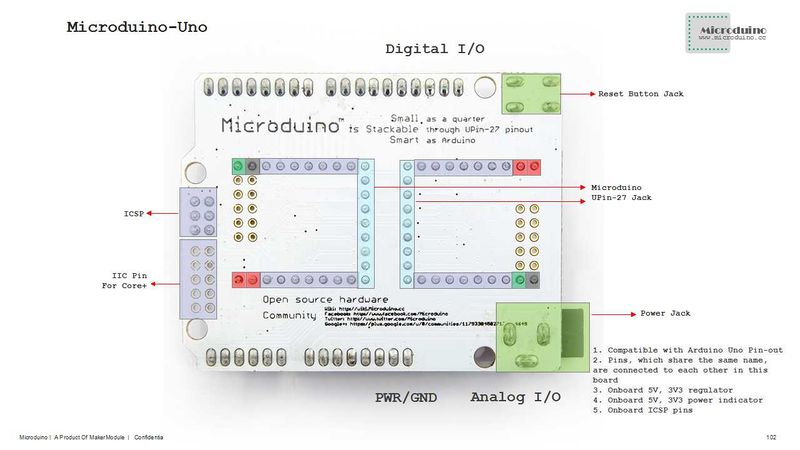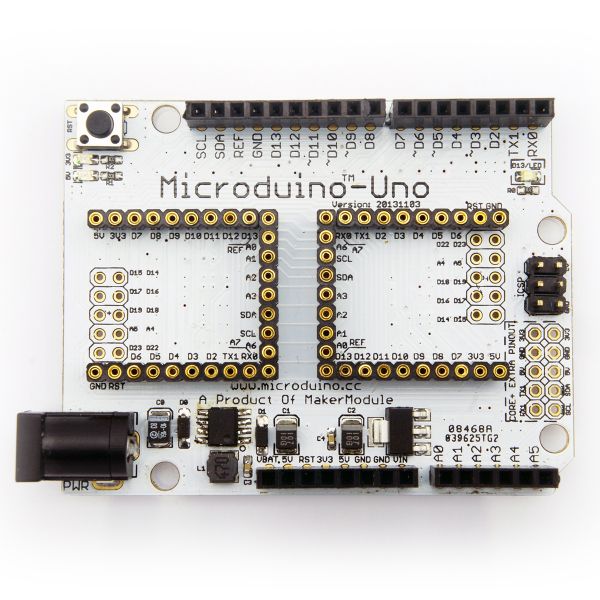Difference between revisions of "Microduino-Shield UNO"
From Microduino Wiki
| Line 4: | Line 4: | ||
| | | | ||
[[file:Microduino-Uno-ks.jpg|400px|thumb|right|Microduino-Uno]] | [[file:Microduino-Uno-ks.jpg|400px|thumb|right|Microduino-Uno]] | ||
| − | Microduino-Uno is an extension board based on official Arduino board, you can use it just like | + | Microduino-Uno is an extension board based on official Arduino board, you can use it just like an Arduino with Microduino FT232R and Microduino Core modules. |
|- | |- | ||
| | | | ||
==Features== | ==Features== | ||
| − | * | + | *Compatible with the pin of Arduino Uno; |
| − | * | + | *Wide-voltage DC power input (8 ~ 35V) supportable; |
| − | *2. | + | *The 2.45-pitch female pin header offers base for Microduino modules and pins with the same name are connected to the base, making it easy for debugging; |
| − | * | + | *Uniformed Microduino interface standard and rich peripheral modules, capable of having a fast and flexible connection and extension with other modules and sensors in accord with Microduino interface standard; |
| − | |||
==Specifications== | ==Specifications== | ||
| − | * | + | *Wide voltage DC power input (8 ~ 35V input) supportable; |
| − | *5V and 3.3V | + | *5V and 3.3V regulated power; |
| − | * | + | *LED indicator connected to D13 digit I/O port and lightened up with high electrical level; |
| − | + | Onboard reset button; | |
| − | * | + | *With serial port(RX1,TX1), I2C(SCL,SDA), power(5V,3.3V)and ground pin added; |
| − | *ICSP pin | + | *Onboard ICSP pin; |
| − | *Two Microduino UPIN27 | + | *Two Microduino UPIN27 bases interconnected to the board. |
[[File:Uno-Pinout-1.jpg|800px|thumb|center|Microduino-Uno-Pinout]] | [[File:Uno-Pinout-1.jpg|800px|thumb|center|Microduino-Uno-Pinout]] | ||
| Line 30: | Line 29: | ||
Eagle PCB '''[[File:Microduino-UNO.zip]]''' | Eagle PCB '''[[File:Microduino-UNO.zip]]''' | ||
| − | ===Main | + | ===Main Components=== |
| − | *Switching | + | *Switching Chip:LM2674 '''[[File:LM2674.pdf]]''' |
*LDO regulator chip:ASM1117 '''[[File:AMS1117-3.3.pdf]]''' | *LDO regulator chip:ASM1117 '''[[File:AMS1117-3.3.pdf]]''' | ||
| − | *Wound Chip Power | + | *Wound Chip Power Inductor:RWPA4018S '''[[File:RWPA4018S.pdf]]''' |
| − | *Schottky | + | *Schottky diode:SOD123 '''[[File:SOD-123.pdf]]''' |
==Development== | ==Development== | ||
| − | + | Microduino-Uno is capable of having a fast and flexible connection and extension with other modules and sensors in accord with Microduino interface standard. | |
==Application== | ==Application== | ||
| − | You can download the program that Microduino provides to test the LED connected to I/O port | + | You can download the program that Microduino provides to test the LED connected to D13 I/O port: |
| − | *Prepared Hardware:Microduino | + | *Prepared Hardware:Microduino FT232R, Microduino Core and Microduino UNO; |
| − | *Prepared Software:Microduino provides testing program(Arduino | + | *Prepared Software:Microduino provides testing program(Arduino part)and Arduino IDE(version 1.0 and higher); |
| − | *Open Arduino IDE's Blink test program, | + | *Open Arduino IDE's Blink test program, choose the board "Microduino Core (Atmega328P@16M,5V)" and download directly. After finishing download,you can see the onboard LED flashes one time per second; |
==Pictures== | ==Pictures== | ||
Revision as of 07:53, 12 August 2014
| Language: | English • 中文 |
|---|
|
Microduino-Uno is an extension board based on official Arduino board, you can use it just like an Arduino with Microduino FT232R and Microduino Core modules. |
ContentsFeatures
Specifications
Onboard reset button;
DocumentEagle PCB File:Microduino-UNO.zip Main Components
DevelopmentMicroduino-Uno is capable of having a fast and flexible connection and extension with other modules and sensors in accord with Microduino interface standard. ApplicationYou can download the program that Microduino provides to test the LED connected to D13 I/O port:
Pictures |





